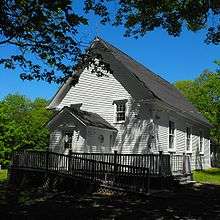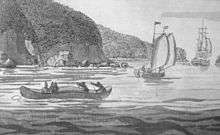Bear River First Nation
Bear River First Nation (Mi'kmaq: L'sɨtkuk[1]) is a Míkmaq First Nations band government located in both Annapolis County and Digby County, Nova Scotia. As of 2012, the Mi'kmaq population is 103 on-Reserve, and approximately 211 off-Reserve.[2]

Bear River First Nation lies adjacent to the village of Bear River, Nova Scotia. It has a church, Saint Anne's, completed in 1836, and a school which serves toddlers and preschoolers.[3] The Mi'kmaq language is taught to children attending the school.[4] A health centre was established in 1998.[5][6]
History

Archaeological evidence suggests the community has existed in the area for 2,000 to 4,000 years. It lies in the ancient District of Kespukwitk, a part of the Mi'kmaq nation.[7][8] The people of Bear River are the Indigenous community whose ancestors welcomed Pierre Dugua, Sieur de Mons, Samuel de Champlain and others who settled at Port-Royal in 1605.[9] The sakmow, or chief, at that time was Henri Membertou who befriended the French. The area around Port-Royal was the traditional summering site of Membertou's people.[10]
The community were known as canoe builders who used their craft for fishing and hunting porpoise, in the Annapolis Basin and Bay of Fundy. Oil rendered from the porpoise was sold as a machine lubricant into the early part of the twentieth century.[11][12][13]
Tourism
Each summer the Bear River First Nation Heritage & Cultural Centre offers authentic cultural immersion in the life and traditions of the Mi'kmaq, featuring hands-on craft-making workshops.[14]
Composition
The Bear River First Nation is composed of three parts as shown, of which the largest is regularly occupied:[15]
| Community | Area | Location | Population (as of 2016) | Date established |
|---|---|---|---|---|
| Bear River 6 | 633.8 hectares (1,566 acres) | 17.6 km. southeast of Digby | 138[16] | March 3, 1820 |
| Bear River 6A | 31.2 hectares (77 acres) | 9.6 km. southeast of Annapolis Royal | 0 | March 3, 1938 |
| Bear River 6B | 24.3 hectares (60 acres)[17] | 6.4 km. southeast of Annapolis Royal | 16[17] | October 1, 1962 |
See also
References
- "About L'sitkuk (Bear River First Nation)". Archived from the original on 2013-10-15. Retrieved 2013-08-21.
- Bear River First Nation: Population Registered Archived December 22, 2015, at the Wayback Machine
- Community Profile
- Bear River Educational Profile Archived July 6, 2011, at the Wayback Machine
- Bear River First Nation Health Centre
- Bear River First Nation: Health Centre Archived 2013-12-24 at the Wayback Machine
- Bear River First Nation: Our History Archived 2013-12-24 at the Wayback Machine
- Paul, Daniel N. (2000). We Were Not the Savages: A Mi'kmaq Perspective on the Collision Between European and Native American Civilizations (2nd ed.). Fernwood. p. 33. ISBN 978-1-55266-039-3.
- Bear River First Nation: The French
- Faragher, John Mack (2005). A Great and Noble Scheme: The Tragic Story of the Expulsion of the French Acadians from Their American Homeland. W.W Norton & Company. p. 12. ISBN 978-0-393-05135-3.
- Mi'kmaq Resource Centre (UCCB), Brief History of Muin Sipu (Bear River) and Early Porpoise Hunting Archived February 18, 2011, at the Wayback Machine
- Bear River First Nation: The Porpoise Hunt
-
- A film by Alexander H. Leighton about a porpoise hunt and rendering of porpoise oil (late 1930s).
- Nova Scotia.com
- Mi'kmaq Resource Centre (UCCB), Mi'kmaw Bands in Nova Scotia, 2010
- "Census Profile for Bear River 6". 2016 Census. Statistics Canada.
- "Census Profile for Bear River 6B". 2016 Census. Statistics Canada.